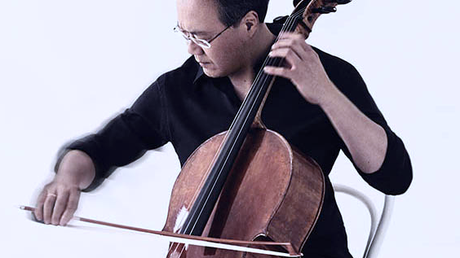
Yo-Yo Ma. Photo © 2019 Sony Classical.
The last compositions by any composer, especially those with shortened lives like Modest Mussorgsky and Piotr Ilyich Tchaikovsky, command a certain respect from listeners. This week at the New York Philharmonic, the orchestra played works by each man, flanking the New York premiere of a new concerto for pipa and cello by the second-generation Chinese composer Zhao Lin. The orchestra was conducted by Long Yu, who has developed a tremendous reputation in his own country (he has been referred to as the "Chinese Valery Gergiev") but has yet to break into podium stardom here.Mr. Yu opened the Saturday evening concert with the Prelude to the opera Khovanshchina, the last, uncompleted work by Mussorgsky. (The composer, battling alcoholism in his last years, assembled his own libretto from historical sources, but had trouble transferring the work into a music drama. Mussorgsky only completed piano versions of the first four acts of the opera. As a result, there are different, extant versions of Khovanshchina, most notably orchestrated by Rimsky-Korsakov and Shostakovich. (Of the third, a collaboration between Stravinsky and Ravel for Paris, only the last act has survived.)
Here, the Rimsky-Korsakov was chosen. It is a bit lighter and sweeter, with a greater emphasis on folk-melodic line and the birdcalls that twitter back and forth in the early pages of this short prelude. A rising folk melody evokes dawn over the city of Moscow, and a series of dark chords recreate the tolling bells of the Kremlin. They also suggest the menacing fate that awaits all the characters in this opera, which chronicles the fates of those who opposed the rise of Peter the Great to the Russian throne.
Mr. Lin's concerto is subtitled A Happy Excursion, an optimistic title that reflects the Nietzschian nicknames that Mahler considered for his Symphony No. 3. Soloist Yo-Yo Ma, in a prefatory speech, explained that each of its three movements were drawn from different periods of Chinese history: the distant past before the Middle Kingdom's foundation, the renaissance of the T'ang dynasty, and the bustling modern day. Throughout the piece, Mr. Ma was joined by Wu Man, a key member of the Silk Road Ensemble, the international music collective founded by the cellist. Her instrument, the pipa is an elaborate, pear-shaped Chinese lute.
For two instruments that have little in common historically, the cello and pipa make a harmonius pair. Mr. Ma's bow carved out lyric themes that were given a hard edge by Ms. Wu's strumming and plucking. Often, Mr. Zhao wrote for the two instruments in unison, adding percussive weight to the dark tone of the cello and creating a new, hybrid sound of West meeting East. Each movement also gave the orchestra plenty to do, and under Mr. Yu's detailed leadership the sound swelled and soared through each historical age.
It is almost impossible for the experienced listener to separate Tchaikovsky's Sixth Symphony, the Pathetique from the sad fact that its creator died nine days after its premiere. It is most unconventional in form: three bold, vaguely determined minor-key movements (the last a blazing march for brass and percussion) followed by a crie de couer finish. This agonizing slow movement has been referred to as the composer's "suicide note", and debate still rages among musicologists whether Tchaikovsky's death, from cholera contracted from drinking a glass of unboiled water, was an act of choice, coercion or unfortunate accident.
The Philharmonic continues to play Tchaikovsky like a boss, and it is debatable whether Mr. Yu's leadership had much to do with the efficacy of this performance. The first movement, with its upward-surging main subject was thrilling in itself, music of dignity lent weight by strong orchestral execution. The slow, agonized dance movement seemed to hang frozen in the air, with double reeds plaintively sobbing. The brassy third movement impressed some audience members so much that they automatically applauded and some reached for their coats. These early departures missed a sensitive performance of the slow, fade-out finale, a grim close to this saddest of symphonies.
If you enjoyed this article, it's time to click over to Superconductor's Patreon page, and help support the cost of independent music journalism in New York City at the low cost of just $5/month.

